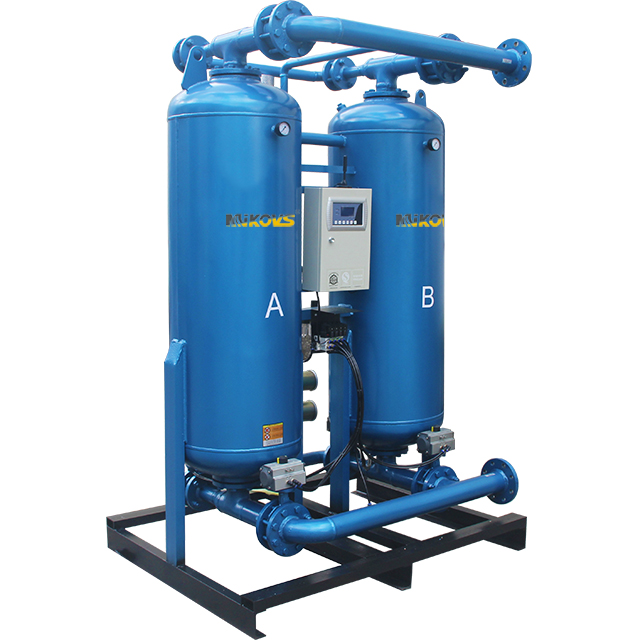Compressed air drying
Over compression
Overcompression is the simplest way to dry compressed air.
The first is that the air is compressed to a higher pressure than the expected operating pressure, which means the water vapor density increases. Afterwards, the air cools and the moisture condenses and separates. Finally, the air expands to operating pressure, reaching a lower PDP. However, due to its high energy consumption, this method is only suitable for very small air flows.
Absorb dry
Absorption drying is a chemical process in which water vapor is absorbed. Absorbent materials may be solid or liquid. Sodium chloride and sulfuric acid are frequently used desiccants and the possibility of corrosion must be considered. These methods are not commonly used because the absorbent materials used are expensive and the dew point is only lowered.
adsorption drying
The general working principle of a dryer is simple: when moist air flows through hygroscopic materials (usually silica gel, molecular sieves, activated alumina), the moisture in the air is adsorbed, so the air is dried.
Water vapor is transferred from the moist compressed air into the hygroscopic material or “adsorbent”, which gradually becomes saturated with water. Therefore, the adsorbent must be periodically regenerated to restore its drying capacity, so the dryer usually has two drying containers: the first container dries the incoming air while the second one is being regenerated. When one of the vessels (the “tower”) is finished, the other is fully regenerated. The achievable PDP is generally -40°C, and these dryers can provide sufficiently dry air for more stringent applications.
Air consumption regeneration dryer (also known as “heatless regeneration dryer”)
There are 4 different methods of desiccant regeneration, and the method used determines the type of dryer. More energy-efficient types are usually more complex and, therefore, more expensive.
Oil-free screw air compressor with MD suction dryer
1. Pressure swing adsorption regeneration dryer (also called “heatless regeneration dryer”). This drying equipment is best suited for smaller air flows. The realization of the regeneration process requires the help of expanded compressed air. When the working pressure is 7 bar, the dryer consumes 15-20% of the rated air volume.
2. Heating regeneration dryer This dryer uses an electric heater to heat the expanded compressed air, thus limiting the required air consumption to 8%. This dryer uses 25% less energy than a heatless regeneration dryer.
3. The air around the blower regeneration dryer blows through the electric heater and contacts the wet adsorbent to regenerate the adsorbent. This type of dryer does not use compressed air to regenerate the adsorbent, so it consumes more than 40% more energy than a heatless regeneration dryer.
4. Compression heat regeneration dryer The adsorbent in the compression heat regeneration dryer is regenerated by using compression heat. The heat of regeneration is not removed in the aftercooler but is used to regenerate the adsorbent. This type of dryer can provide a pressure dew point of -20°C without any energy investment. Lower pressure dew points can also be obtained by adding additional heaters.
Air blast regeneration dryer. While the left tower is drying compressed air, the right tower is regenerating. After cooling and pressure equalization, the two towers will automatically switch.
Before adsorption drying, the condensate must be separated and drained. If the compressed air is produced by an oil-injected compressor, the oil-removing filter must also be installed upstream of the drying equipment. In most cases, a dust filter is required after the adsorption dryer.
Compression heat regeneration dryers can only be used with oil-free compressors because their regeneration requires very high temperature regeneration air.
A special type of compression heat regenerative dryer is the drum dryer. This type of dryer has a rotating drum with adsorbent adhered to it, and a quarter of the drum is regenerated and dried by hot compressed air at 130-200°C from the compressor. The regenerated air is then cooled, the condensation water is drained away, and the air is returned to the main stream of compressed air through the ejector. The other part of the drum surface (3/4) is used to dry the compressed air from the compressor aftercooler.
There is no loss of compressed air in the compression heat regeneration dryer, and the power requirement is only to drive the drum. For example, a dryer with a processing flow rate of 1000l/s consumes only 120W of electricity. Additionally, there is no loss of compressed air, no oil filter, and no dust filter required.
Statement: This article is reproduced from the Internet. The content of the article is for learning and communication purposes only. Air Compressor Network remains neutral with respect to the opinions in the article. The copyright of the article belongs to the original author and the platform. If there is any infringement, please contact us to delete it.

